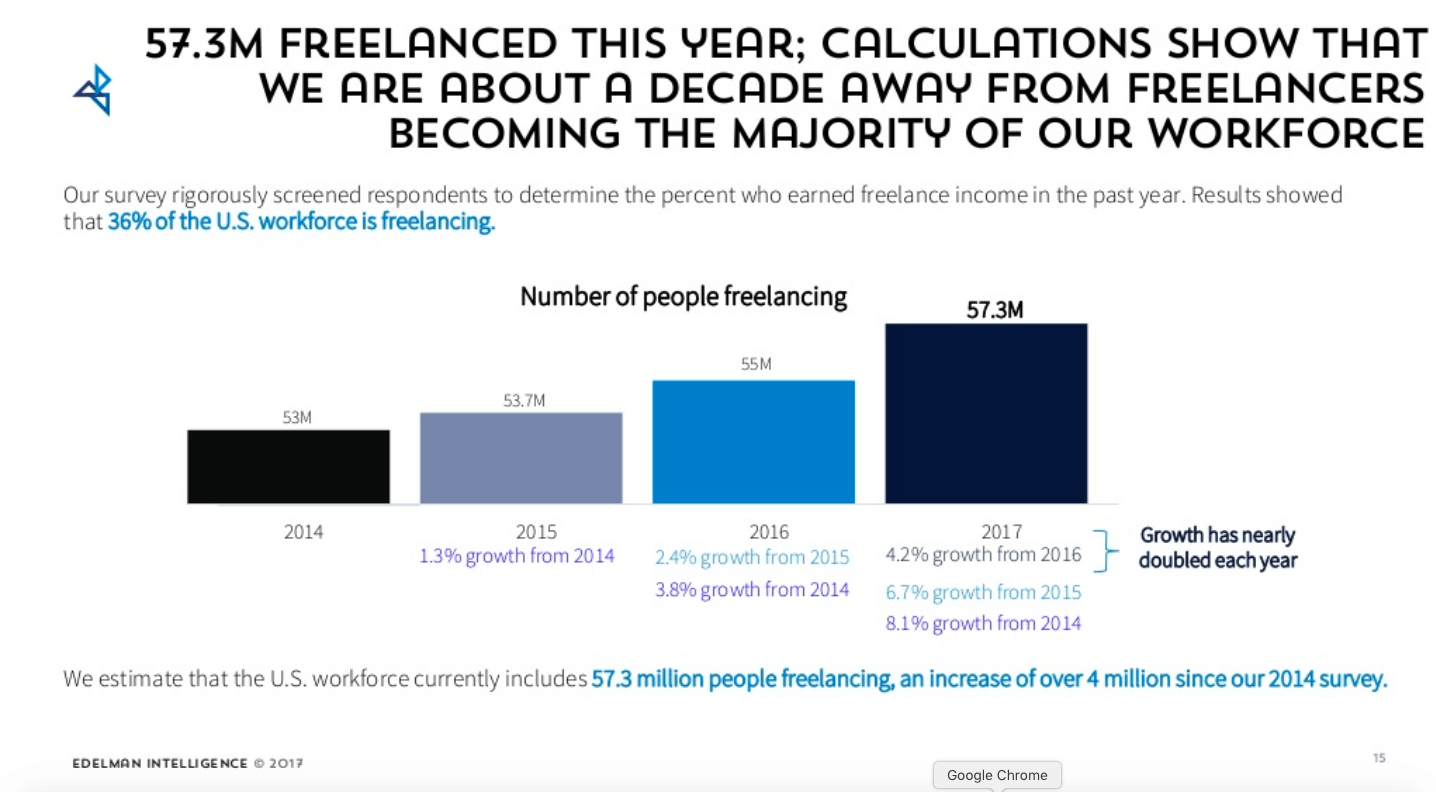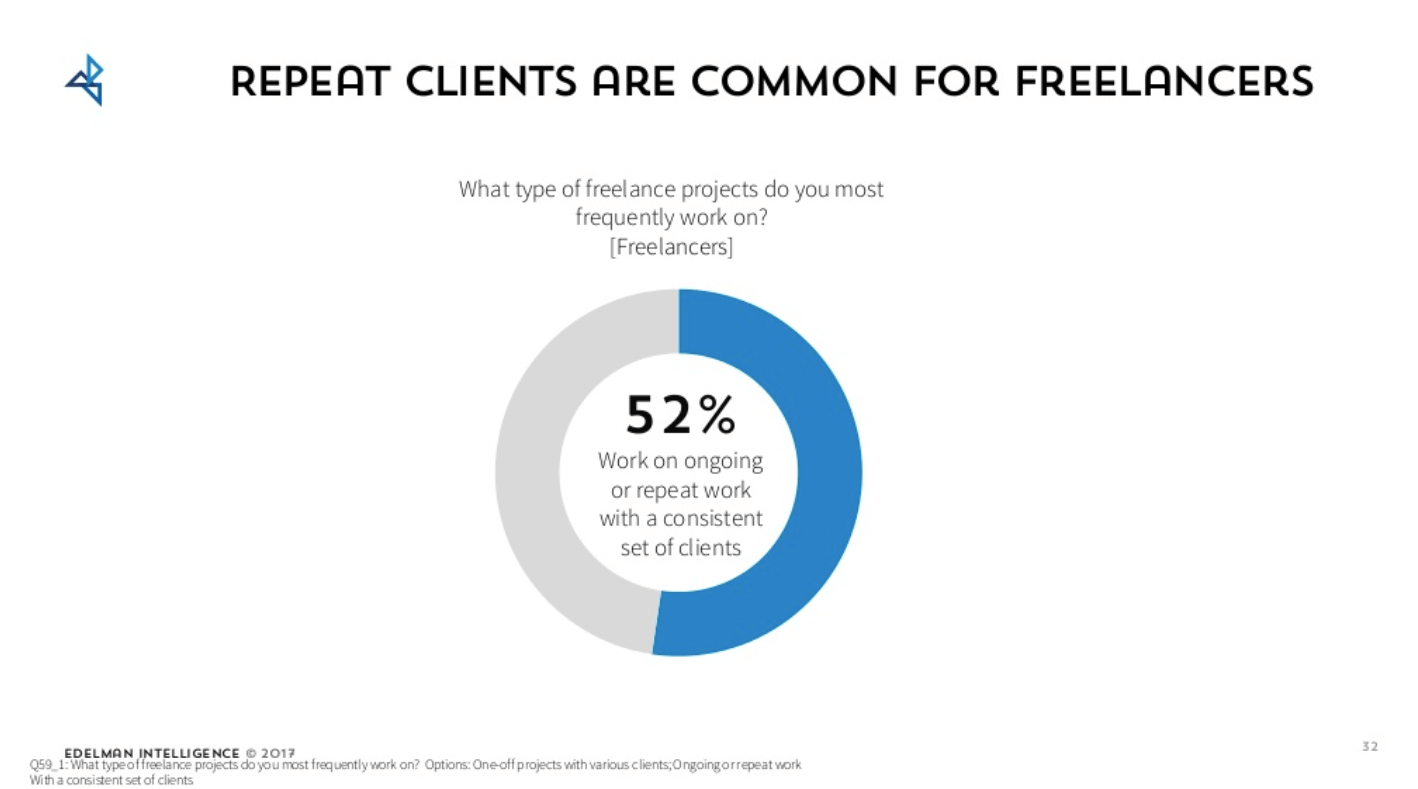How Small Businesses Can Leverage the Freelance Economy
With the advent of platforms like Upwork, Elance, and Freelancer.com, the freelance economy has absolutely exploded.
According to a 2017 study on Freelancing in America conducted by Edelman Intelligence, there are over 57 million freelancers working in the United States alone. That’s over 35% of the workforce!
What’s perhaps even more telling, is that a strong majority of freelancers (63% to be exact) feel more financially secure with diversified income as opposed to just one employer. Freelancers in the study average 4.5 clients per month.
Freelancers are also now investing in skill development on a regular basis. The study found 55% of freelancers reskilled within the last 6 months! That’s almost double the 30% of others who reskilled within the same time frame.

So what does this revolution mean for small businesses? Expert human resources, that were formerly only available to small businesses as full-time hires, can now be afforded on an as-needed basis.
It’s not dissimilar to the flexibility the SaaS model has provided to smaller businesses over the past decade. After all, the SaaS boom opened the door for budget-strapped organizations to leverage tools formerly reserved for enterprises and pay to use them monthly on a subscription basis, without a huge up-front investment.
In the same way, the freelance economy allows the hiring of highly skilled labor on a pay-as-you-go basis.
Of course, it’s not a cake walk. There are plenty of concerns and complaints that come along with the freelance economy, many of which are valid.
The trick to making the most out of this exciting opportunity is knowing how and when to leverage the freelance economy for your small business.
Let’s cover how you can do just that.
Know When to Hire Freelancers
Sometimes, given the flexibility of working with freelancers, it can seem overly tempting to forego traditional employees. Whether you’re in need of an Adobe Illustrator expert, a back-end developer, or just a versatile VA, the freelance marketplace will indeed be able to accommodate.
But it’s important to give this some serious thought and choose carefully. Particularly if you’re going to be forming long-term relationships with freelancers, there are some pros and cons worth considering.
Pros of Working with Freelancers
One of the biggest benefits of working with freelancers is that you’ll only pay for what you need.
With an employee who has a dedicated schedule, small business owners are often stuck paying for some inevitable downtime. There may not always be enough work to cover the shifts a part-timer is scheduled for, and that can lead to some serious budgetary waste.
Freelancers, on the other hand, can be paid on a per-project basis. You can also easily arrange a “week to week” basis for scheduling work. That flexibility dramatically reduces the chances that you’ll pay workers more than you need to.
With freelancers, small business owners are also often able to hire more skilled help than they would be able to support otherwise. Maybe there’s a need for a marketing expert to help with one specific high-impact campaign. But the business owner wouldn’t be able to afford a six-figure salary for a full-time employee with those skills, let alone have enough work to fill their time. By leveraging the freelance economy, highly-experienced (and expensive) help can now be contracted for that one important project without breaking the bank.
Last but not least, there’s not a lot of pressure to keep new freelancers on if they’re not performing. Instead of needing to invest time, energy, and money in helping a freelancer grow into the role you hired them for, you can more easily swap to someone that will take less time to pick up the pace.

Cons of Working with Freelancers
One undeniable downside of working with freelancers is that it’s all too easy for them to move on when a better-paying gig comes up. And, when you’re scheduling week to week, you might not know until the last minute when they’re planning to take a week (or a month) off to travel or to work on another project.
Without benefits and other “hooks” that you can have in full-time employees to encourage them to stay on, freelancers are understandably free to move on or change their availability at any time. And this will happen.
Who can blame them? Loyalty is a great thing to value–but the point of working with freelancers is that you’re essentially choosing not to pay for their loyalty. Put yourself in the freelancer’s shoes. If you’re offered the same flexibility but an extra $5/$10 an hour from a different company, what would you do?
If you can’t afford their new rates, or can’t wait for them to fit you into their calendar, you may need to deal with training and incorporating a new freelancer.
Another downside to working with freelancers is that if significant training and onboarding is required, that can easily end up being a sunk cost when the freelancer moves on. You may be better off exploring a full-time employee with whom that initial investment can pay off for years to come.
How to Find the Right Freelancers
When it comes to picking freelancers, you’re going to be spoiled for choice. We already covered that over 57 million Americans are freelancing, and it’s even projected that the majority of the American workforce will be freelancing by 2027!
So the power is going to be in your camp as a business owner looking to outsource some of your workload. Given this power dynamic, there’s little reason to “settle” for anything less than an ideal arrangement.
Determine What You Can Afford
Start by browsing the talent pool and getting a feel for what level of experience demands what range of hourly or project-based pay. Next, take into account how many hours each week you’ll need a freelancer to reach your goals. You’ll also need to determine what your budget looks like.
With all of that in mind, come up with a price range that gets you the most experienced talent you can manage given the expected workload and the going rates. I find that building a spreadsheet is a key component to success at this point in the process. Laying out all of the data you’ve collected in an easy-to-digest format will allow you to make a more well-informed decision. And, if you get pushback from the freelancers or others in your business who feel the price is too low or too high, you’ll have plenty of evidence to back up your thinking.
Build a List of Prospects
After you’ve made a decision about what level of talent you want to hire, and what your expectations are around hours and availability, it’s time to start finding prospects.
Browse your platforms of choice, and add your candidates to a new page on your spreadsheet. If you’ve never hired a freelancer online, here are some of the most trusted and well-respected platforms to consider:
The more information you track the better. That way you can make sure you get a good idea of where individual strengths and weaknesses may lie.
After you have a list, it’s time to do some interviews!
Picking a Finalist
This is probably a topic for another day, since there simply isn’t enough space to cover how to do a good interview right here in this article.
But at a bare minimum, be sure to ask screening questions to ensure that the freelancer actually possesses the skills and knowledge that they claim to. It’s also wise to ask for some references and to see a portfolio or examples of previous work. Pay attention to whether not they’ve done freelance work before as well–they may have the right skills, but if they’re new to freelancing, managing their hours and projects could be more unpredictable.
Hopefully, after a round or two of interviews, you’ll have a few finalists that you’re excited about. From this point, you can either do a second round of interviews, or you can try running a small trial project with each of them to see how well they can deliver results.
Set Clear Expectations and Processes
One thing to remember when working with freelancers in 2018 is that you likely won’t see them in person on a regular basis. That means that there are countless opportunities for things to slip through the cracks.
In order to avoid frustration on both ends, start out by setting extremely clear expectations with each freelancer you hire. The more you “codify”, the more likely it is that your processes will be followed to a T.
Here are a few of the key items you’ll want to cover with each freelancer before they begin logging hours.
-
- Working hours
-
- Methods of communication
-
- Project Management or time tracking tools and methods
-
- Payment method and time-frame
- NDA or non-compete agreements if appropriate
The more you communicate, the less room there is for confusion. We’ll cover communication in greater detail next.
But for now, just remember that any additional work you put in up front to prepare will save you time and headaches later. If you set clear expectations, you’re far more likely to get the results you’re hoping for.
Communication is Key
Communication is one of the first places that the freelancer-business owner relationship can start to break down.
If preferred methods of contact and expectations for response time aren’t laid out ahead of time, freelancers may miss messages and notifications. Especially if they’re abroad, they may not get in touch during your business hours, and that can cause some serious frustration.
Small businesses should focus on the principle of “over-communication” when it comes to working with freelancers.
For the most part, the more you communicate, the better. The more instruction you give, the more likely you are to get the results you’re hoping for. Don’t leave room for misunderstanding or corner cutting.
It is of course, important not to go down the micromanagement rabbit hole. That path will end up costing more of your time, rather than saving it. This is also an appropriate time to mention that you’ll want to keep your own expectations within reason as well. Freelancers will rarely be available to drop what they’re doing and firefight for you. Keeping this in mind, and setting reasonable expectations, will help make your freelance relationships far more successful.
Communicating effectively is one of the foundational pillars of success in the freelance economy. Put the time and energy in up front, and you’ll be rewarded with better working relationships and more expeditious results. The best freelancers are good communicators themselves, too.
Freelancers Ultimately Empower Small Business Owners
The truth is, the explosion of the freelance economy has significantly empowered many small business owners to reach new heights and provide higher-quality products and services.
But like any new avenue of business growth, it requires a degree of precision and diligence to get right. Follow the tips above and you’ll be well on your way to improving your own business thanks to the freelance economy.
At RankPay, we’ve spent years fine-tuning our own process of working with freelancers to great effect. Thanks to some very talented freelancers, we’ve made leaps and bounds with our own marketing campaigns and partner collateral, while maintaining the ability to quickly experiment and iterate.
Further, the freelance economy is a perfect ideological match for how we approach business and SEO. Since we specialize in performance-based SEO, we only get paid if we generate results!
Was this helpful?